Contentos Review: Decentralised Global Content Ecosystem
Contentos is a project that has been picking up steam lately. This has piqued the interest of the markets as trading volumes of COS break new records.
They are another blockchain based project that is trying to develop a fairer decentralised alternative for content creators. This is more than just a concept as a number of streamers and YouTubers have got on board with Contentos.
However, is the project worth considering?
In this Contentos review, I will attempt to answer that. I will also take a look at the technology and long term use cases and price potential of the COS token.
What is Contentos?
Contentos is aiming to change the digital content industry and restore fairness for content creators by basing its decentralized video and content platform on blockchain technology.
The development team wants to empower creators, and give everyone the means to record their lives digitally, maintaining complete ownership and control.

The Contentos platform is created to ensure an orderly environment for content producers that is both open and equitable and allows for the delivery, promotion, rights protections and transactions centered around global content production.
Contentos Ecosystem
The Contentos blockchain was specifically tailored to address the needs of the content industry, and it expects to be able to deliver transaction confirmations immediately and at zero cost through its Self-Adaptive Byzantine Fault Tolerant (saBFT) consensus mechanism.
This will make the content platform suitable for the high-frequency interactions common in a content-driven community, such as thumbs-up, commenting, and rewards.
Contentos is well on the way to realizing its vision, with the public testnet going live this past march 2019, and the mainnet expected to launch in September 2019. Real users are already being slowly transitioned to the network to verify the user carrying capacity and ecological reward mechanism of the network.
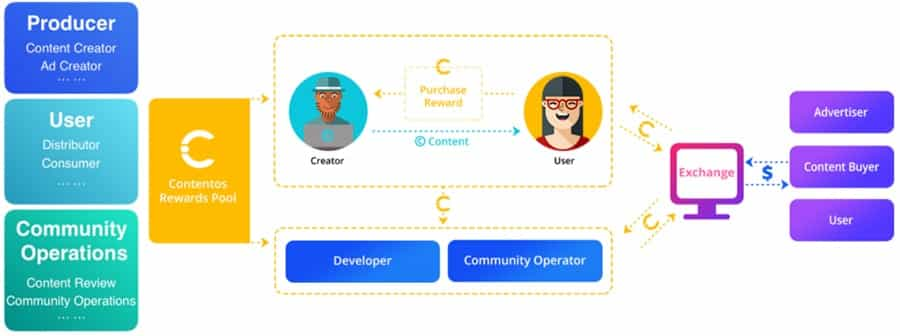
The Contentos platform has been built with three critical infrastructures based on the system requirements envisioned by the developers:
- A decentralized digital content system for the distributed storage of content and to create a decentralized content agreement with creators. This will allow content creators to receive benefits directly from advertisers and viewers without needing to access the centralized platform channel.
- Financial system to accommodate digital asset storage and transactions, and the creation of the encrypted tokens that will be used for all transactions in the platform such as purchases and gifting, advertising, inter-platform payments, and any other financial transactions. Furthermore, all transactions can be completed through the use of smart contracts which free users from the need for third-party intermediaries.
- The creation of a social network that will link all of its users through the generation, delivery and dissemination of content, while also incentivizing creation through the use of a reward system. Also combine this with a credit rating system that makes each user accountable for their actions on the platform, thus creating order within the community.
The way the Contentos platform currently functions there are several roles users can adopt, which include content producers, content distributors, bookkeepers, technical developers and social operators. Users can fill more than one role on the platform, and enjoy equal rights for each role and with each node in the network.
Contentos Vs. Centralized Systems
With the rise of blockchain technology, it’s become possible to reexamine the business model of centralized platforms. This led the Contentos team to the realization that the current content platforms suffer from three major bottlenecks.
Let's take an in-depth look at each of these shall we?
1. Unfair Distribution of Revenue
The entire industry suffers from an irrational and unfair distribution of revenue. Despite the fact that the most important part of any content delivery platform is the content creators themselves, the current models don’t address this properly.
The current centralized platforms have two glaring issues: Creators often stand on the margins of the industry and are unable to interact directly with consumers and advertisers. Because of this most of the value in their creations is extracted by the centralized platform and its related payment channels.
Secondly, the traffic distribution on centralized platforms is opaque, and because traffic distribution decisions are based on revenues, the producers on such platforms will often cater to the platform simply for the sake of traffic. This makes it difficult, if not impossible, for new producers and creators to gain traction in the absence of traffic.
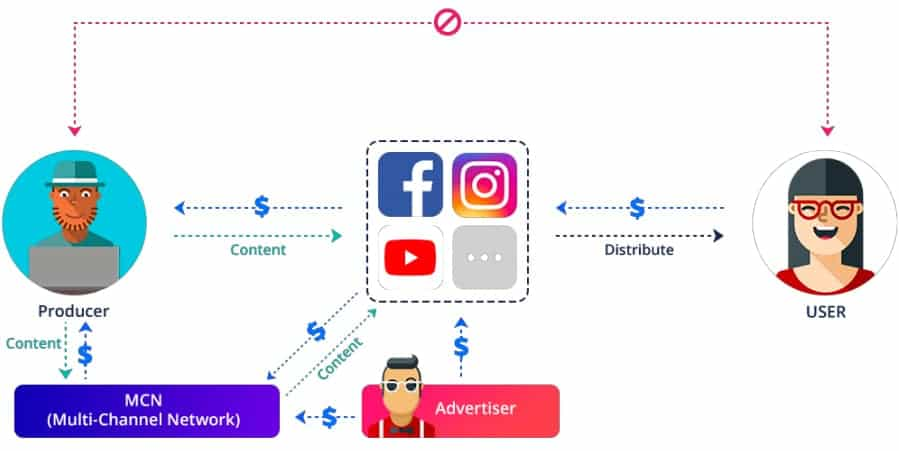
The way in which the two interact has shown the centralized content industry is on a trend that leads to homogeneous content quality. This all prevents users from getting the content they truly want, instead, they have to settle for the content promoted by the platform. Contentos plans on solving this problem with a decentralized revenue and traffic distribution system.
The traffic delivery on Contentos is designed to be decentralized, and works on its own in response to the descriptions and labeling of videos. Artificial intelligence is employed to personalize the content delivery based on user preferences.
Content delivery can be made more accurate by defining the target audience, or distribution can be determined organically through comments, thumbs-up, etc.Prices for everything within the Contentos ecosystem are completely transparent and open.
With prices calculated through an open formula and written indelibly to the blockchain everything is maintained as fair and equal for creators, users, advertisers and all other participants.
2. Intellectual Property Rights
In the current centralized content creation and delivery platforms, it’s common for users rights to be infringed upon, because it is often difficult to accurately conform who holds the rights to digital content.
The massive amount of content posted to the internet on a daily basis has created this issue, partially due to the fact that each platform is standalone and separate from all other platforms. Add to that the extremely complex transactions that can occur online and it becomes increasingly difficult to trace who is the ultimate copyright holder of the content.
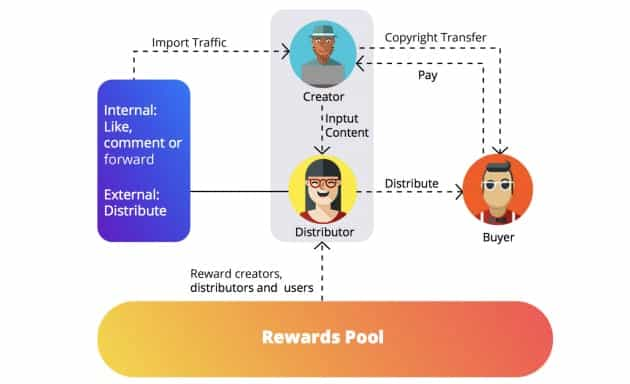
There is also difficulty in enforcing penalties, which all leads to frequent copyright infringement and disputes. Contentos can solve this issue through the indelible nature of the blockchain.
With a trustless and secure blockchain, it is easy for content creators to register their original work works, and make it completely clear of the origin and copyright of any content added to the platform. Any secondary creation and sharing of content is also fully and indelibly recorded on the blockchain.
3. Lack of Transparency
Content creators on centralized platforms often need to worry about the abuse that is endemic due to the useless credit systems on these platforms. This comes about because all of the comments, thumbs-up and other data on centralized platforms is not transparent and open.
Users on these platforms need not worry about accountability, and can make any comments they like, even if they are untrue, malicious or violent. Contentos plans on solving this problem through the addition of an untampered credit system. By using blockchain technology everything on the platform is recorded and is unable to be tampered with.
That means everything a user does on the platform is transparent and remains on the blockchain forever. Users who abuse the system or others can see their credit decline, and only through positive, honest behaviors can users upgrade their credit rating. This is encouraged because higher credit ratings also lead to higher credibility on the platform and increased revenues.
By lining revenues tightly with the credit rating of users they are more incentivized to act in a positive manner. This should lead to an orderly evaluation system, with a healthy and transparent ecosystem.
Contentos Technology
Contentos has introduced the Self-Adaptive Byzantine Fault Tolerance mechanism to its Delegated Proof of Stake (DPoS) consensus mechanism, giving the network improved speed and lower cost. Additionally, Contentos system provides the JSON RPC-based interface service and supports the front end applications to be accessed by HTTP, HTTPS or Web socket.
Contentos Architecture
The technical architecture of Contentos has three layers; the protocol layer, the services layer, and the application layer. The protocol layer is based on STEEM, but adds IPFS and interchain, which has increased the properties for the side chains.
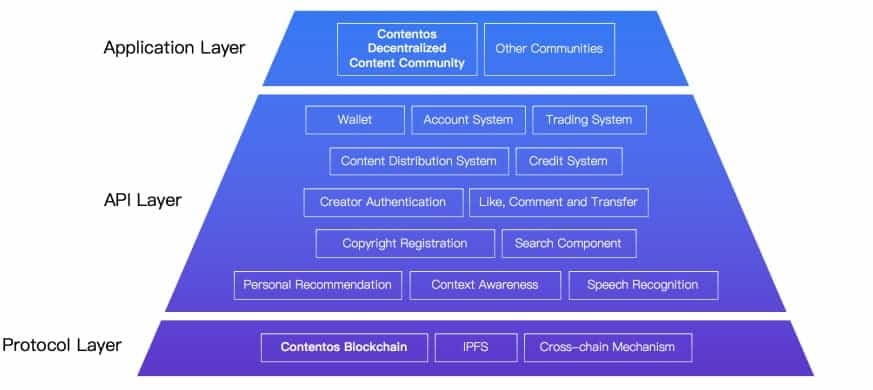
The service layer uses an artificial intelligence audit combined with the blockchain to encourage users to carry out content audits. The application layer provides prepackaged APIs to increase development speed and help grow the Contentos community.
Contentos Consensus
As mentioned above, Contentos uses a BFT-based consensus algorithm known as saBFT. This mechanism actually uses three different consensus models; linear, real-time, and hybrid. It supports atomic swaps and can be customized to use intelligent dynamic selection.
In this mode, the intelligence algorithm is based on network hash rate, transaction volume waiting for confirmation, and other factors which helps to choose the appropriate consensus model.
The Contentos Team
The most recent information shows the Contentos team consisting of 45 members, with more than half of them working on development. The most important part of the team is the leadership, which begins with co-founder and CEO Mick Tsai.
Mick has been working in the software industry for over 15 years and previously worked as Senior Product Director at LiveMe and Senior Development Manager at Trend Micro. He graduated from California State University with a Masters Degree in Computer Science.

The Vice President of Engineering at Contentos is Peter Wei, who has over 13 years experience as a software developer. His primary expertise lies in security protocols, encryption algorithms, and data structures. His previous employment at HTC and Cheetah Mobile saw him focusing on mobile application technology.
Zac Nien is the Vice President for Product at Contentos. He graduated from National Tsing Hua University in Taiwan with a Masters Degree in Information Systems and Applications. Following university he worked primarily in IT security, gathering 10 years experience. In his role as Senior Engineer at Trend Micro, he worked on software programming, website design, Internet of Things and all kinds of apps.
Ava Wen handles the oversight of marketing for Contentos as its Vice President of Marketing. She comes to the project with a number of years experience in the entertainment and digital content industries. This experience helps her find practical solutions to improve the content delivery ecosystem.
The COS Token
Contentos held its ICO from May 25, 2019, through June 10, 2019, and sold 3 billion of the total supply of 10 billion COS tokens.
The sale price at the ICO was $0.016 and the team raised a total of just over $30 million. Current COS tokens are ERC-20 tokens, however, once the mainnet launches these ERC-20 COS tokens will need to be exchanged for native COS tokens.
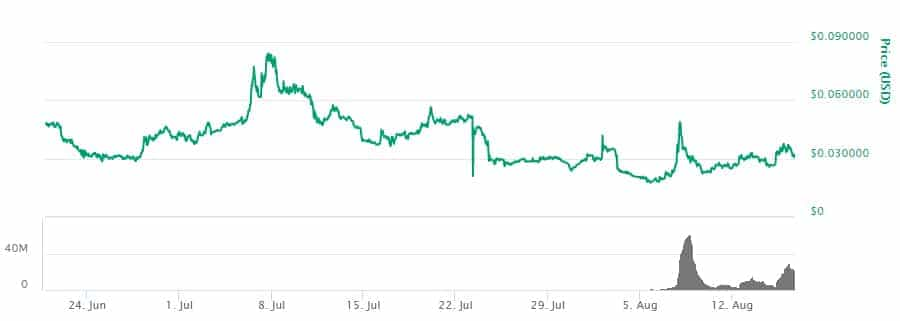
The price of the tokens jumped immediately following the ICO and hit an all-time high of $0.085396 on July 8, 2019. The price dropped rapidly after hitting the all-time high and COS reached an all-time low of $0.015776 roughly 2 weeks later on July 24, 2019.
Since that time price has recovered somewhat, and is at $0.032069 as of August 16, 2019.
Buying & Storing COS
Currently, the only exchange where COS is trading is Binance. This means that the token faces a key exchange risk from a liquidity perspective. If ever there was a situation in which the tokens trading were to cease on Binance, there would be no place to trade the token.
Having said that, given that it is based on the Binance chain, it is unlikely to drop trading for the token. There is also healthy liquidity on the books which means that you can easily execute your orders with not that much slippage.

Currently, COS tokens can be stored in any ERC-20 compatible wallet, however, the team has moved to Binance’s BEP-2 and any ERC-20 tokens should be converted to BEP-2 tokens. Once the mainnet launches all ERC-20 and BEP-2 tokens will need to be converted to native COS tokens.
Development & Roadmap
I wanted to take a deeper look into the Contenos development work as this is a direct reflection of the overall progress on the protocol.
One of the best ways to objectively measure this is through the activity on their public code repositories.
Hence, I decided to head on over to the Contentos GitHub to get a better idea of what code the developers were pushing. Below are the total commits to the three most active repositories.
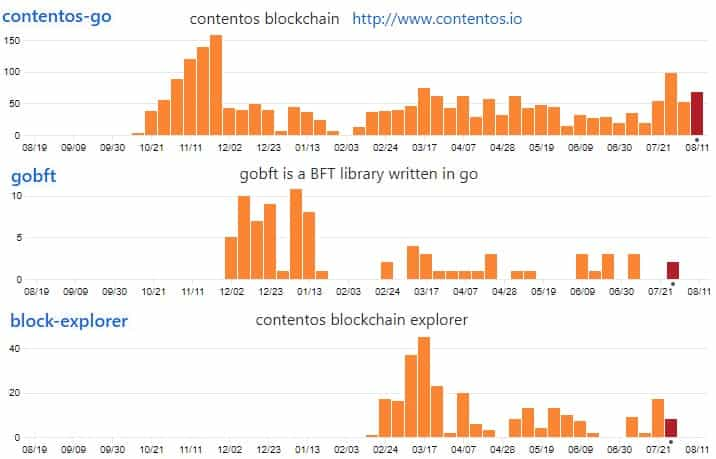
As you can see, the project has been quite busy over the past year and they have been pushing numerous commits. It is also worth pointing out that there are a further 19 other repositories with varying levels of activity.
This is more than we usually see in projects that are at similar stages in their life. This activity is probably related to the ambitious milestones that the developers have included in their roadmap.
Below are some of the most important milestones that they are coming in the pipeline for 2019:
- v 1.0 of Testnest: Making use of the SABFT consensus mechanism as well as status monitoring of the blockchain
- v 2.0 of Testnest: Start with user testing by bringing in the photo creator & game livestreaming
- v 3.0 of Testnest: This will be the block producer election stage as well as the smart contract template creation.
- v 4.0 of Testnest: This stage of the testnet will bring in the reputation system as well as the copywrite authorisation system.
- v 5.0 of Testnest: This will be the complete testnet that will be put through its paces before the mainnet launch.
- v 1.0 Mainnet: If all has gone well up to this stage then the team can progress to the mainnet stage and complete the token swap to their native token. They will also onboard live users in the ecosystem
So, there is quite a lot that they still hope to get done in the year
This is indeed quite ambitious so it will be interesting to see how things progress from here. If you wanted to keep track of the development then you could head onto their official blog.
Conclusion
Contentos is a fairly new project, but it has strong backing from Binance and a number of Chinese investors. Because the platform is based in China it hasn’t been well known thus far in Europe and North America, but we imagine that will change once the mainnet is launched and the project is ready to sign up new users.
There is competition for Contentos as well. The best known is likely the STEEM blockchain, which is the oldest blockchain based social network. It has had its own problems, but Contentos feels it can avoid those problems through its use of saBFT and the credit system that will ensure users behave in the best interests of the platform.
It’s far too early to know if Contentos can be successful, but with over a billion potential users in China alone it should be able to grow rapidly. Beyond that, it will remain to be seen if the platform is sticky for users, and if it performs as the development team plans.
Disclaimer: These are the writer’s opinions and should not be considered investment advice. Readers should do their own research.
